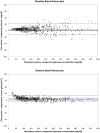Measures of Accuracy for Continuous Glucose Monitoring and Blood Glucose Monitoring Devices
- PMID: 30453761
- PMCID: PMC6501529
- DOI: 10.1177/1932296818812062
Measures of Accuracy for Continuous Glucose Monitoring and Blood Glucose Monitoring Devices
Abstract
Currently, patients with diabetes may choose between two major types of system for glucose measurement: blood glucose monitoring (BGM) systems measuring glucose within capillary blood and continuous glucose monitoring (CGM) systems measuring glucose within interstitial fluid. Although BGM and CGM systems offer different functionality, both types of system are intended to help users achieve improved glucose control. Another area in which BGM and CGM systems differ is measurement accuracy. In the literature, BGM system accuracy is assessed mainly according to ISO 15197:2013 accuracy requirements, whereas CGM accuracy has hitherto mainly been assessed by MARD, although often results from additional analyses such as bias analysis or error grid analysis are provided. The intention of this review is to provide a comparison of different approaches used to determine the accuracy of BGM and CGM systems and factors that should be considered when using these different measures of accuracy to make comparisons between the analytical performance (ie, accuracy) of BGM and CGM systems. In addition, real-world implications of accuracy and its relevance are discussed.
Keywords: ISO 15197; MARD; accuracy; blood glucose monitoring; continuous glucose monitoring; performance.
Conflict of interest statement
Figures


References
-
- American Diabetes Association. Standards of medical care in diabetes—2018. Diabetes Care. 2018;41(suppl 1):s1-s156. - PubMed
-
- Food and Drug Administration. PMA P120005/S041: FDA summary of safety and effectiveness data. https://www.accessdata.fda.gov/cdrh_docs/pdf12/P120005S041b.pdf. Accessed March 27, 2017.
-
- Food and Drug Administration. Premarket approval (PMA): FreeStyle Libre flash glucose monitoring system (P160030). https://www.accessdata.fda.gov/scripts/cdrh/cfdocs/cfpma/pma.cfm?id=P160030. Accessed November 13, 2017.
-
- Hirsch IB, Bode BW, Childs BP, et al. Self-monitoring of blood glucose (SMBG) in insulin- and non-insulin-using adults with diabetes: consensus recommendations for improving SMBG accuracy, utilization, and research. Diabetes Technol Ther. 2008;10:419-439. - PubMed
Publication types
MeSH terms
Substances
LinkOut - more resources
Full Text Sources
Other Literature Sources
Medical

